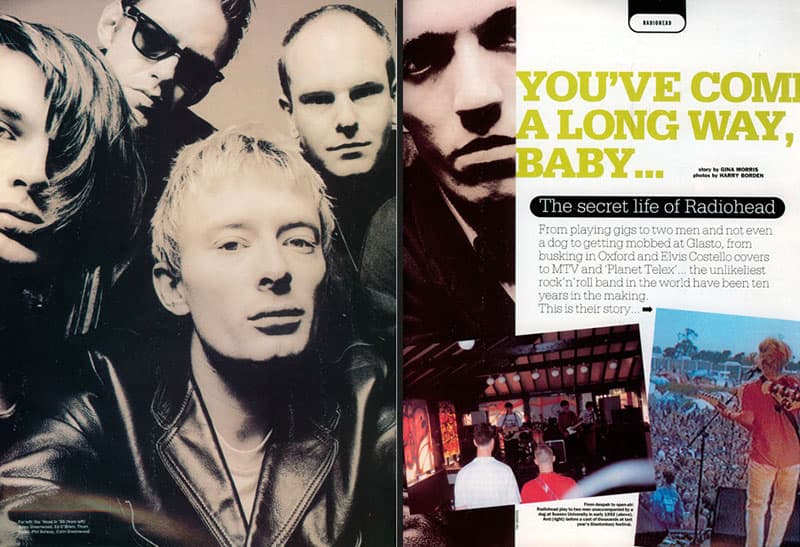Radiohead has been established as a major ‘alternative rock’ band for more than 20 years and has sold over 30 million albums worldwide. However, when I first photographed the band, back in 1993, they were at the beginning of their career. Their first album, released a few months earlier, had received mixed reviews, though the single ‘Creep’ showed they had enormous potential.
I was asked to photograph them by the music magazine Select. The pictures would be published with a feature about ‘The secret life of Radiohead’. I was initially told I would photograph them in a studio, but we actually did the shoot in a garage in a down-at-heel part of Cowley in Oxfordshire. It wasn’t the ideal location to shoot a portrait of five people.
It was the beginning of my career and I photographed them in black & white, in a sort of Anton Corbijn style. It was one of the first shoots they had done. I got on well with the band members; they were friendly and clearly very intelligent and interesting people. The following year, when their album The Bends was released, they kindly sent me a signed copy to thank me for the shoot. When I heard it, I realised they were an amazing band. I became a big fan and bought all their subsequent albums.
Then, in 2007, I was offered another opportunity to photograph the band, this time for the Observer Music Monthly. They were about to release their seventh album, In Rainbows. In the 14 years since I’d photographed them, they had progressed from being a small indie band to a stadium band with a massive following.
They were also a more cerebral outfit than most other bands, so I thought carefully about how I would photograph them. I definitely didn’t want to turn up completely unarmed to photograph a band of hip and savvy people.
The Observer had hired a room at Holborn Studios in north London, but I aimed to do something different from the average studio shoot. I wanted to approach it from an alternative angle, to include some element of performance and encourage the band members to be fully engaged and collaborative.

An early photo shoot with Radiohead by Harry Borden in 1993 appeared in now-defunct music magazine Select.
With all that in mind, I came up with the concept of allowing the band to photograph themselves. I liked the idea because they seemed empowered and in control of their destiny, so it seemed an appropriate approach, as well as being quite funny. I talked it through with the magazine’s editor, who agreed, then bought an infrared cable release so the band could fire the camera’s shutter themselves.
When they arrived for the shoot, I explained the idea to them and they were really up for it, so I went ahead with setting it up. We had the biggest studio at Holborn. The equipment included a splendid block and tackle arrangement that I’d often admired, so I decided to incorporate it in the shoot. I attached one light to it with an Octa softbox, which I love using. I only used one light because when it comes to lighting I always believe that less is more. My Canon EOS 1Ds Mark II was set up on a tripod with a 50mm lens attached.
I asked the band to stand under the Octa and arranged the band members with lead singer Thom Yorke at the front. Then I gave him the infrared cable release asked him to point it at the camera. I let him take the pictures until the memory card was full. One of those images was used on the cover of Observer Music Monthly.
After we had done that scenario, I borrowed my assistant’s 1DS Mark II and asked the band to stand in the same places as they were when taking their own picture. Then I switched the radio sync to my assistant’s camera and shot the whole set-up from a different angle.
I got some frames of my assistant standing by the camera, but ultimately the set-up worked best when it was just the band taking pictures. My favourite shot, shown here, has Thom Yorke giving a knowing look to my camera.
This picture was used inside the magazine. As well as being something different and eye-catching, it works well over a double-page spread and allows plenty of space for text to be overlaid. This portrait has since been shown in lots of exhibitions, titled ‘Radiohead Photographs Themselves’ and prints have sold well. I think it’s because the picture references the kind of band Radiohead is.
After the shoot had ended and the band had left, I noticed that bass player Colin Greenwood had left his navy-blue bomber jacket on the back of a chair. I took it home, meaning to return it, and later emailed the record company, but no one got back to me. I still have the jacket and I’m reminded of the shoot every time I open my wardrobe. I occasionally still wear it, but if Colin happens to be reading this article and wants it back, I’d be more than happy to oblige.
Harry Borden is one of the UK’s finest portrait photographers. He has won prizes at the World Press Photo awards (1997 and 1999) and in 2014 he was awarded an Honorary Fellowship by the Royal Photographic Society. The National Portrait Gallery holds over 100 of his images. His new book Survivor: A Portrait of the Survivors of the Holocaust is available now.







